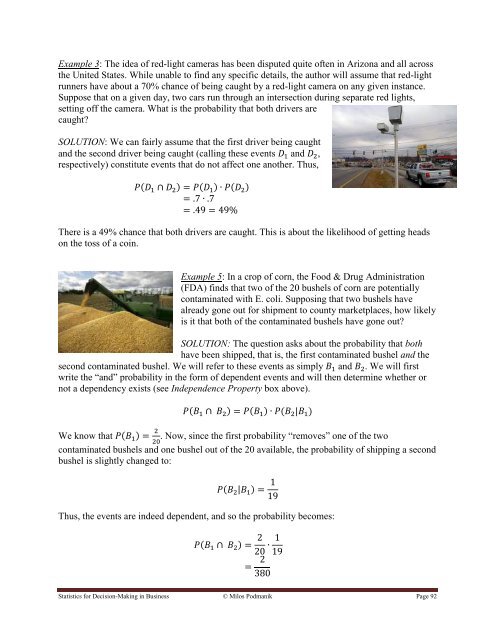Statistics for Decision- Making in Business - Maricopa Community ...
Statistics for Decision- Making in Business - Maricopa Community ...
Statistics for Decision- Making in Business - Maricopa Community ...
You also want an ePaper? Increase the reach of your titles
YUMPU automatically turns print PDFs into web optimized ePapers that Google loves.
Example 3: The idea of red-light cameras has been disputed quite often <strong>in</strong> Arizona and all across<br />
the United States. While unable to f<strong>in</strong>d any specific details, the author will assume that red-light<br />
runners have about a 70% chance of be<strong>in</strong>g caught by a red-light camera on any given <strong>in</strong>stance.<br />
Suppose that on a given day, two cars run through an <strong>in</strong>tersection dur<strong>in</strong>g separate red lights,<br />
sett<strong>in</strong>g off the camera. What is the probability that both drivers are<br />
caught<br />
SOLUTION: We can fairly assume that the first driver be<strong>in</strong>g caught<br />
and the second driver be<strong>in</strong>g caught (call<strong>in</strong>g these events and ,<br />
respectively) constitute events that do not affect one another. Thus,<br />
( ) ( ) ( )<br />
There is a 49% chance that both drivers are caught. This is about the likelihood of gett<strong>in</strong>g heads<br />
on the toss of a co<strong>in</strong>.<br />
Example 5: In a crop of corn, the Food & Drug Adm<strong>in</strong>istration<br />
(FDA) f<strong>in</strong>ds that two of the 20 bushels of corn are potentially<br />
contam<strong>in</strong>ated with E. coli. Suppos<strong>in</strong>g that two bushels have<br />
already gone out <strong>for</strong> shipment to county marketplaces, how likely<br />
is it that both of the contam<strong>in</strong>ated bushels have gone out<br />
SOLUTION: The question asks about the probability that both<br />
have been shipped, that is, the first contam<strong>in</strong>ated bushel and the<br />
second contam<strong>in</strong>ated bushel. We will refer to these events as simply and . We will first<br />
write the “and” probability <strong>in</strong> the <strong>for</strong>m of dependent events and will then determ<strong>in</strong>e whether or<br />
not a dependency exists (see Independence Property box above).<br />
( ) ( ) ( )<br />
We know that ( ) . Now, s<strong>in</strong>ce the first probability “removes” one of the two<br />
contam<strong>in</strong>ated bushels and one bushel out of the 20 available, the probability of shipp<strong>in</strong>g a second<br />
bushel is slightly changed to:<br />
( )<br />
Thus, the events are <strong>in</strong>deed dependent, and so the probability becomes:<br />
( )<br />
<strong>Statistics</strong> <strong>for</strong> <strong>Decision</strong>-<strong>Mak<strong>in</strong>g</strong> <strong>in</strong> Bus<strong>in</strong>ess © Milos Podmanik Page 92
















